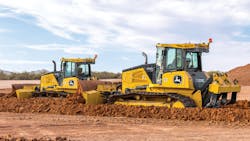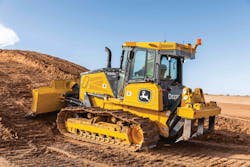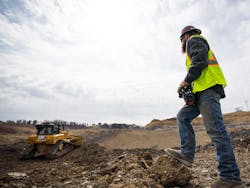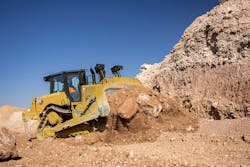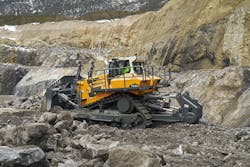The work done by today's dozers remains recognizable to anyone spotting a busy construction site or roadside repair project. But what may not be easily seen is the new efficiency and accuracy in the work taking place before their eyes. Grades remain constant and are done quickly, effortlessly. This, at the hands of operators who may also have quite a bit less experience on the job than expected. That said, the work of dozers gets done, quickly, safely, and with more accuracy than ever as a result of technology working right alongside the power and muscle of these dozers, to continue changing our landscapes.
Making the Work as Training-Free as Possible
For those heavily involved with dozers, technology is often thought of as some type of grade control technology, according to Matt Goedert, solutions marketing manager with John Deere Construction and Forestry. “At John Deere we want to make it easier for the operator to grade; electronically controlled systems allow us to accomplish this separate from a grade control system. The power management system we have on our crawlers from the 450K all the way up to the large dozers—such as the 1050K—has the ability to be managed for such things as controlling its transmission automatically.
“For example, if you are in a dozer and encounter a hard spot or change in material, the power management system simply adjusts the hydraulic load of the transmission, as well as maintaining the ideal RPMs to keep the tracks from slipping and breaking loose. This system increases efficiency and allows the machine to keep moving, adjusting the hydraulics and transmission to be as efficient as possible.”
Slope control or entry-level grade control is available on the 700L and 750L model John Deere Dozers and expanding to additional models in the future. The use of these features on equipment is aimed at novice and experienced operators. Slight grades are difficult to grade over large areas, according to Goedert. Now the desired grade can be dialed in and the blade can be controlled automatically to maintain grade quality.
“What we've found is in slope control, depending on the operation, with the novice operator slope control improves the smoothness of the grade by 30%," adds Goedert. "When you think about that aspect it greatly improves just the quality of the grade as a novice operator, and with accuracy as well.
“So if we are trying to keep a certain slope over a large distance, depending on the application, for a novice operator, we found slope control can improve the accuracy by up to 40%. Both the accuracy and smoothness of the grade are greatly altered. That, as opposed to manually controlling the grade or slope.”
To make the work easier to accomplish, slope control was introduced just recently, in summer 2020. In the future, John Deere plans to expand that feature out for additional dozer models. "As we were rolling it out, we tested with operators of different experience levels and try to be within a tenth of a foot of the correct grade, so that 40% improvement or gets us inside that one-tenth of a foot accuracy.
"Slope control is an entry-level solution. If there's more complex work or tight tolerances, the SmartGrade solution is available for our 650 dozer up to our 950K dozer. This is a 3D factory-integrated control solution, using Global Navigation Satellite System to get down to really within that one-tenth to five-hundredths of a foot accuracy.”
Another aspect of SmartGrade remote support is wireless data transfer, allowing the customers and dealers to remotely transfer files to and from the machine. “So maybe on that SmartGrade machine every time they get close to the curb line on the project the equipment dips. The problem might be something that might not have anything to do with the machine itself.
“Dealers can transfer a 3D model, take a look at it using software on the computer to make sure there are no unexpected dips on the 3D model as well as make sure everything else is smooth. Along with these features, technicians can also monitor components on the machine and parameters such as engine oil pressure or temperature.
“As far as muscle goes, one thing to point out is Eco-Mode on all of our dozers. Traditionally when operators think of a type of economy mode, they perceive running in this setting will sacrifice productivity. But what we have done in our Eco-mode is design it so we can save fuel by up to 20% depending on the application without sacrificing productivity.
“We accomplish that by reducing engine RPMs when a machine is not experiencing heavy loads because at that point the power is not required. By lowering RPMs, we save on fuel, slowly ramping up the power when needed."
As with others in a wide variety of industries, Goedert hears from customers daily on the shortage of skilled operators. They utilize customer advocate groups for discussing so-called pain points with clients, seeing how things can be improved through their input.
“In those customer advocate groups we receive input, ask them what they'd like to see in the product, and then bring them back into the middle of development to get their overall opinions. It's a pretty cool opportunity for customers to build the machine and then at the other end see the finished product. Anything improving automation helps the customers."
Building On Successful Long-Standing Technology
Caterpillar's new technology features are easy to upgrade. Stable Blade helps to smooth out the grading through its input. Other core technology features have been upgraded as well. The input of your hand and how it controls the dozer lever can be done.
“We smooth that command out and also how the blade reacts to your hand,” explains Sam Meeker, Caterpillar dozer specialist. "This is done to give you the ability to do smoother grading and also do this somewhat faster when you are manually controlling the dozer.
“With a new sensor, new algorithm, and with some new software behind it, there's a noticeable improvement over the older Stable Blade, already in use for some 12 years. Performance with the dozer blade's been improved. Lots of these features are designed to help out the operator so that they don't even know the features are working. The end goal is a smooth grade without bugging the operator.”
Their Blade Load Monitor includes a basic small GPS monitor atop the machine which 99% of people would never know is there, according to Meeker. This allows operators to know just how much load they're pushing through a display right in front of the operator on the main screen. A bar graph indicates with a green bar that the load is good for the equipment, a yellow bar, starting to slip, and a red bar tells the operator the load is causing increased slippage of the tracks.
“Our studies over many years have shown that going slow while pushing a big load proves to be the most efficient way to push. A little bit of track slip is fine, but not too much while a lot of material is in front of the blade. This Blade Load Monitoring is something of an onboard training system to give the best data for the work and a push as well as being especially good for new operators.
“Blade Load Monitoring also tells operators where they are in terms of the load information. They do not have to react in terms of raising the blade; the auto carry automatically kicks in and manages the blade height to maintain optimum fit. Auto carry is designed for maximum productivity too.
“An application such as the Blade Load Monitor responds to what I am doing on the machine. It's cool. We try to be interactive, engaging to the operator, grabbing their attention, and keeping it so they are learning how to run their dozer the best it can be done. I feel it must be mentioned that we designed these new Assist features (Stable Blade, Slope Assist, Blade Load Monitoring, Traction Control, and Autocarry) to help operators become better, not replace them with technology.”
In addition to new state-of-the-art security systems protecting valuable machinery, Cat dozers have remote control features for operating in environments where hazards prove too great for the use of a person operating onsite. Scenarios requiring remote operations include areas of possible slides and high wall cracks near edges of the work area, among many others.
An over-the-shoulder console may be used featuring a 1,300-foot line of sight in such operations. A remote station can be placed onsite allowing operators to work without being inside the cab itself but still running the dozer. "This way there is no exposure of the person running the equipment to hazardous environments, including gases which may be toxic,” adds Meeker. “The operator can be running the dozer from 3 miles away or 3,000 miles away with very little lag time involved.
“In one demonstration during the Bauma Munich Trade Show, guests at the show (in Munich, Germany) ran dozers in Edwards, IL, and Green Valley, AZ, at Caterpillar's Demonstration and Learning Center facilities. We have customers using this technology on mine sites in the middle of nowhere, on coal piles where vibratory hoppers lead to conveyors shoveling coal away. In bridging a coal pile there can be great danger from a dozer going down in the event of a collapsing coal bridge.”
Meeker describes a case where an operator who no longer had the use of his legs could now operate the dozer just fine remotely. "We want to take new operators and help them improve. We don't want to put a Band-Aid on there and not make things better, but teach them how to be a better dozer operator. In the end, a huge goal is just making the operation of a dozer fun experience, to engage people.”
New Technology Allows Work Both Onsite and Off
Komatsu is heavily involved with their next iteration of intelligent Machine Control (iMC 2.0) according to Jon Jennings, product marketing manager. “This is our next leap forward with a whole fleet of new features to enhance automatic dozing,” explains Jennings. “They all go toward improving work with everything for every part of the project, from bare grass to finish grade on the job site. No one else can offer an integrated automatic solution for stripping and lifting. We can run automatics all the time."
One of those features is called proactive dozing. The dozer measures the terrain it tracks over and uses that data to plan the next pass. If there is a rise in the terrain ahead the equipment can anticipate that just like an operator would. Plus, the operator and equipment can be proactive instead of reactive regarding the upcoming landscape situation.
“When it hits that rise and senses a low spot, the automation remains in action. We are heading in the direction of more intelligence, and more efficiency, than previously possible. Proactive dozing is the name Komatsu applies to this technology.
“The equipment senses that it is going to need to lift the blade before the operator is even at that spot. This is also a way to try to eke out more and more job site efficiency along with other features. Our studies show that lift layer control improves the time to place the lift by 50%. Reworking is reduced because if the soil remains too thick it won't compact correctly or it may not compact at all."
As with others mentioned here in this article, finding skilled operators gets harder and harder. This comes into focus especially as infrastructure plans appear to be in the works for the near future. The intelligence on the new Komatsu equipment helps bring the operator up to the level of an experienced operator, to within 6% of skilled operators, according to Jennings.
“What is not taken into account are skilled operators having to maintain that level of performance all day, every hour of the week; they may get tired, fatigued,” says Michael Salyers, senior product manager at Komatsu. “The intelligent Machine Control system automatically adjusts the blade, creating less work for the operator. The fatigue level of the operator is lessened as well through the use of automation.
“Helping unskilled operators learn the job is easier with the addition of proactive dozing technology. The logic learns the terrain as the operator works and automatically adjusts the blade to follow that new ground, just as a veteran operator would. This is a giant step up from new operators learning as they go. The technology shortens the learning curve for new operators and their production results when using proactive dozing is only slightly less than their experienced counterpart. This is powerful stuff.”
Tilt control and proactive dozing are some of the leading-edge features recently introduced. “It is important to have automatic operator assist in all parts of the job," adds Salyers. "This also allows new operators to have an easier transition. With the older system, there was a much longer learning curve. Learning on the fly can be done much more smoothly with the new automation."
Komatsu offers digital solutions such as Smart Construction Remote, which allows users to send new design data to machines in the field, and remotely support operators without traveling to the job site.
"We can capture positions and relay that back to the office," adds Jennings. "In the office, the overlay of that new terrain enables the immediate determination of the progress of the machine on a daily, hourly basis to see how much work that machine does, compared to another. Relaying information back into the field, capturing data, and visually analyzing this to make decisions on an instantaneous basis is now a reality.”
Operator Assistance System Allows Greater Precision, Increased Speed
The outstanding features of the small and medium-sized Liebherr crawler dozers (PR 716 G8 to PR 756 G8) include the new electronically-controlled operating hydraulics. Both Free Grade and Definition Grade Operator Assistance Systems come fitted as standard. The Liebherr Silent Design features extensive noise reduction measures. The most notable innovation with the ample PR 766 G8 crawler dozer is the new High Drive for even greater traction as well as more comfort for the driver in heavy-duty mining operations.
Liebherr's new assistance systems on the Generation 8 dozers offer differing levels of operator support including, on demand, Free Grade for active shield stabilization during fine grading and Definition Grade for automatic blade positioning when creating 2D surfaces. Such Liebherr systems are now fitted as standard on the Liebherr PR 716 G8, PR 726 G8, PR 736 G8, PR 746 G8, and PR 756 G8 dozers.
The standard-fit for blade stabilization, in all axes, includes two independent, permanently integrated sensor circuits (gyro and inertia sensors). The combination of hydrostatic drive and an optimized center of gravity delivers both exceptionally high grading speeds and extremely precise grading results. Their 3D Grade option offers a factory-mounted GPS machine control from Topcon, fully integrated and calibrated ex-works. Ready Kits continue offering further options for easy retrofitting of the latest 2D and 3D control systems from Trimble and Leica.

